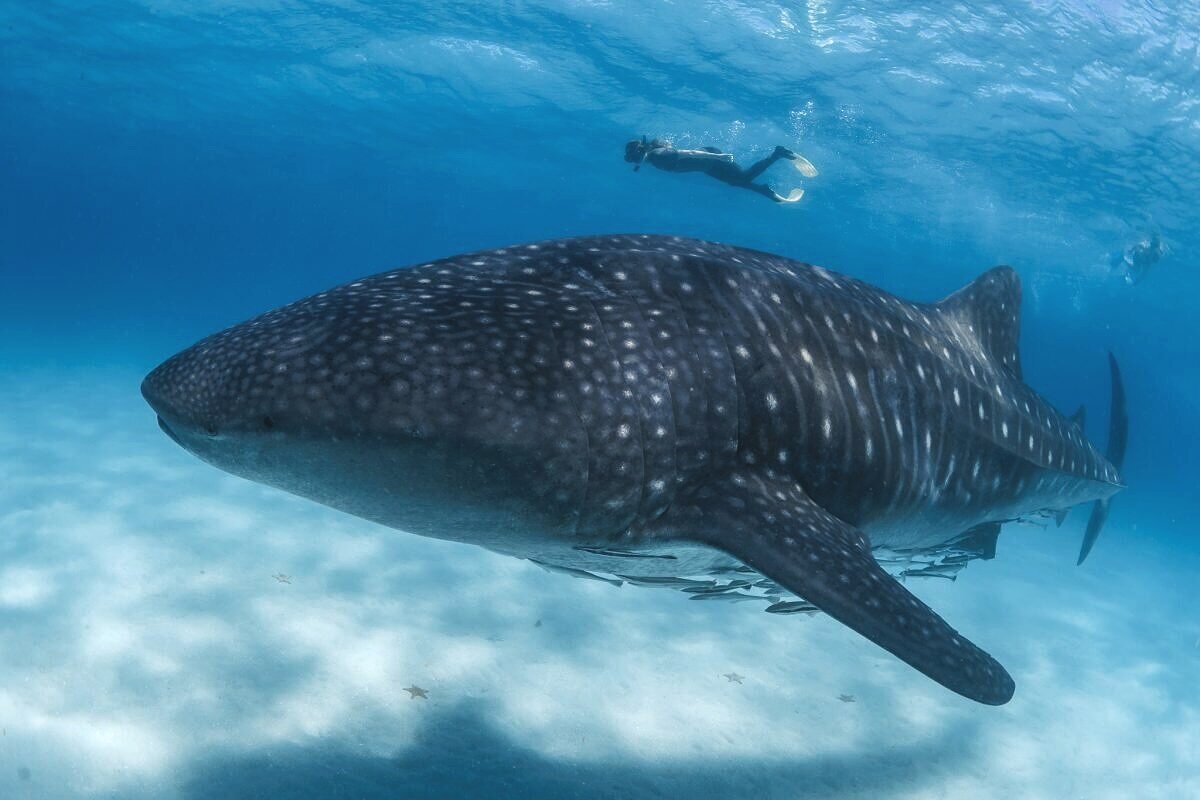There’s no place like home for whale sharks in Tanzania
Global lockdowns pose few problems for whale sharks off Tanzania. New research from The Marine Megfauna Foundation’s (MMF) Mafia Island Whale Shark Research Project shows that these gigantic fish prefer to stay in the bay they call home.
Scientists regard whale sharks as a “highly migratory” species, capable of swimming tens of thousands of kilometers each year. However, a study published today in the journal Frontiers in Marine Science has shown that at least one site, Mafia Island in Tanzania, they like to stay local.
“I’ve worked on whale sharks all over the world, and I’ve never seen anything like it,” said the lead author of the study, Dr. Chris Rohner from MMF. “We usually have to track whale shark movements via satellite. Here, in Tanzania, many of the sharks kept returning to a single bay over months, and across years.”
Whale sharks are the world’s largest cold-blooded animal, growing to 20 m in length, more than 30 tons in weight, and living for over a century. Despite their huge size, these sharks feed solely on plankton and small fishes, and pose no threat to people.
“We used passive acoustic ‘pinger’ tags for this study. Every minute or so, the tags transmit a coded ultrasonic burst that travels around 300 m through the water,” explained Dr. Jesse Cochran, a co-author on the study, working with the King Abdullah University of Science and Technology. “We placed receivers through Kilindoni Bay. As the sharks swam past, the tag code would tell us which shark it was, and when it was there.”
Kilindoni Bay, on the inshore coast of Mafia Island, is close to the mouth of the Rufiji River delta. “We think the river delivers a lot of nutrients into these coastal waters, which makes it a highly productive area. There are huge densities of small shrimp in the warmer months, and that’s when we’d see the sharks enjoying the buffet,” said Dr. Rohner.
New study shows that whale sharks in Tanzania prefer to stay in the bay they call home – despite being regarded by scientists as a ‘highly migratory’ species. Image: Simon J Pierce | naturetripper.com
Mafia Island is an important feeding ground for juvenile whale sharks. The researchers monitored the movements of 51 whale sharks through the Kilindoni Bay receiver array over five years.
“We see lots of sharks on the surface feeding on shrimp between November and February,” said Dr. Clare Prebble from MMF. “Before long, we realised we were seeing many of the same sharks every year. These days, it’s like visiting old friends.”
What the scientists didn’t anticipate was that their data showed many of the sharks stayed in, or close to the bay, across the whole period of research.
“These sharks are real homebodies,” said Dr. Rohner. “By the end of the study, we had almost 200,000 detections on our receivers. We expected to see plenty of sharks in the warm months, but we didn’t think they’d hang around afterward.”
The sharks use a small area close to shore over summer, while they’re feeding on the shrimp. Then they move slightly offshore and spent less time at the surface in the cooler months.
Mafia Island is also an important area for fishing. The whale sharks are traditionally viewed as ‘lucky’ by the fishermen, as the fishes they’re targeting often travel with the sharks.
“The fishermen and whale sharks generally have a good relationship off Mafia Island,” said Dr. Baraka Kuguru from the Tanzanian Fisheries Research Institute. “The fishers use nets to catch small fish, but the small-mesh nets don’t tangle the sharks. The sharks normally swim straight out and resume feeding. We even see them feeding in the nets sometimes. It all seems to work quite well.”
In the last few years though, more threats to the sharks have emerged.
“We’re seeing increasing boat traffic off Mafia, and the sharks are getting hit,” said Dr. Simon Pierce from MMF. “That’s certainly a concern, but worse – a small number of fishermen have started setting big gillnets to catch rays, right in the middle of the whale shark feeding area.”
Dr. Chris Rohner with whale sharks at Mafia Island, Tanzania – where researchers have discovered a ‘local’ population of whale sharks. Image: Simon J Pierce | naturetripper.com
The researchers recommend that whale shark management fees, a mandatory per-person contribution from tourists swimming with the sharks, are shared with fishing communities to compensate them for avoiding the sharks’ main feeding area while the shrimp are present.
“The core ‘home range’ of the sharks’ summer activity is only about 23 km2,” added Dr. Pierce. “It’s a small area, but it’s super important to the sharks.”
“We’ve long been interested in what the whale sharks are doing at Mafia”, said Jason Rubens, who initiated the study through the primary funder, WWF Tanzania. “The island is embracing ecotourism in addition to fishing, and there’s a great opportunity to create sustainable livelihoods while also protecting the sharks.”
“Whale sharks are globally endangered,” said Dr. Rohner. “By ensuring they’re safe in vital feeding areas like Mafia Island, we’re giving them the best possible chance to recover fast. This staycation could really work out in their favour.”
– ENDS –
Notes to Editors
The full study is available online at Frontiers in Marine Science.
For questions about this research, please contact:
Dr. Chris Rohner, Principal Scientist, Marine Megafauna Foundation
Email: chris@marinemegafauna.org
Whale shark photos from Tanzania can be found here. These photos are provided under a Creative Commons with Attribution license for free editorial use. Please include the following credit in your photo captions: Simon J Pierce | naturetripper.com
The Marine Megafauna Foundation (MMF) was created in 2009 to research, protect and conserve the populations of threatened marine megafauna around the world. ‘Megafauna’ are large marine species such as sharks, rays, and sea turtles. For further details, please see www.marinemegafauna.org or follow us on Twitter, Facebook, Instagram and LinkedIn.





